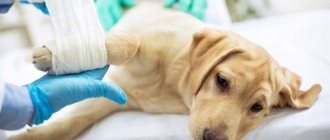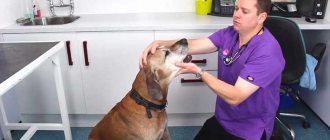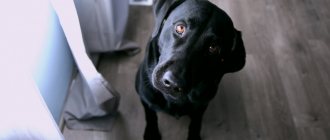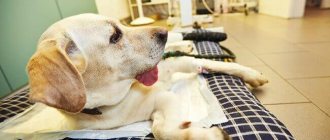A dog's nose bleeds is not a very common occurrence. There can be many reasons for this problem: from trauma to hereditary systemic pathologies. What to do in such a situation depends on the nature of the bleeding and the general condition of the pet.
The nose of animals is one of the most important sense organs. With the help of their sense of smell, pets pick up many times more odors that are inaccessible to humans. Therefore, the blood supply in the organ is very well developed and many vessels are on the surface. Even a slight injury can cause prolonged and heavy bleeding.
What is nosebleed, its types
Nosebleeds are a symptom that is associated either with damage to the walls of blood vessels directly in the nose or in the lower respiratory tract.
The process can be acute, when the symptom appears suddenly, and chronic, if the problem occurs periodically. Based on the nature of the bleeding, owners may note the following manifestations:
- The dog's nose is bleeding profusely; the color may be scarlet (if large arteries are damaged) or darker (venous bleeding).
- Blood droplets periodically appear on the pet's face. Typically, this course is detected in chronic pathologies. The symptom appears during the period of exacerbation of the process, after physical exertion, stress.
- When sneezing, physical irritation of the mucous membrane provokes a protective reflex in the dog, and if the outer membrane is injured, the pet also experiences bleeding from the nose.
- Blood clots from the nose are a sign that indicates a violation of the integrity of blood vessels, which the dog’s body has coped with on its own. The blood clotted and a blood clot formed. However, the situation in any case requires attention and, if the problem occurs frequently, contacting a veterinarian.
Signs
The clinical picture may include:
- blood flowing from a dog's nostrils;
- sneezing accompanied by splashing blood clots;
- swelling of the nose, muzzle;
- noisy breathing;
- odor from the nasal and oral cavity;
- loss of appetite;
- black stools (associated with ingestion and digestion of blood from the nose).
With systemic problems (blood clotting disorders), multiple petechiae (hemorrhages on the skin), bleeding gums, blood in the stool, vomit, etc. may occur.
Why does my dog's nose bleed? Main reasons
As a primary problem, nosebleeds in an animal can occur in the following cases:
- Injury. When the pet has hit itself, damaged the muzzle area with a thorn or other object, etc. In such situations, the animal experiences blood from one nostril, pain, swelling, and visible damage to its integrity.
- Foreign body in the nasal passages and nasopharynx. Pointed parts of toys, spikelets from plants, small twigs injure the mucous membrane, causing unilateral bleeding, frequent sneezing, restless behavior (the animal tries to get rid of a foreign object: rubs its muzzle against surrounding objects, scratches its nose with its front paws).
- Poisoning with rodent poisons. The action of these drugs is aimed at disrupting the production of vitamin K, which is involved in the process of blood clotting and supports bone marrow function. Symptoms after poison enters the pet’s body may appear only after a few days. The dog has copious discharge of blood from the nose, mouth, anus, urethra, general weakness, convulsions, and anemic mucous membranes.
Our services in ophthalmology
The administration of CELT JSC regularly updates the price list posted on the clinic’s website. However, in order to avoid possible misunderstandings, we ask you to clarify the cost of services by phone: +7
| Service name | Price in rubles |
| Appointment with an ophthalmologist (primary) | 3 900 |
| Comprehensive OCT examination of the retina (one eye) | 3 500 |
| Ultrasound scanning of the anterior segment of the eye | 1 000 |
| Revision of the vitreous cavity | 44 000 — 70 000 |
All services
Make an appointment through the application or by calling +7 +7 We work every day:
- Monday—Friday: 8.00—20.00
- Saturday: 8.00–18.00
- Sunday is a day off
The nearest metro and MCC stations to the clinic:
- Highway of Enthusiasts or Perovo
- Partisan
- Enthusiast Highway
Driving directions
Nosebleeds in dogs as one of the symptoms of the disease
The cause of blood from a dog’s nose can be internal pathologies. Then the problem will be just one of the symptoms. Bleeding can occur with the following diseases:
- Hemophilia is a hereditary pathology in which the animal’s clotting process is impaired. Even with a minor injury, it is difficult to stop the bleeding. Pets experience hematomas, bruises, pale mucous membranes, paralysis, and a general depressed state.
- Blood parasitic diseases occur after the bite of a tick that carries the pathogen. The symptom is noted with piroplasmosis, ehrlichiosis. Associated signs are a general depressed state, fever, jaundice, lack of appetite, and the appearance of blood in the urine.
- Infection with helminths that parasitize the airways and arteries (dirofilaria, hookworm, pulmonary capillary). Pathogens cause sneezing, coughing, deterioration in coat quality, and changes in appetite.
- DIC syndrome is a pathology in which, for various reasons, the animal’s blood clotting process is disrupted. The pet has hemorrhages and organ dysfunction (in severe cases, multiple organ failure).
- Von Willebrand's disease is not common in animals and is a genetic disease. Your pet's blood contains a mutated protein that interferes with the clotting process. As a result, spontaneous bleeding, hemorrhages, and red or brown urine are noted.
- Pathologies of the spleen, liver, kidneys.
- High blood pressure. The condition occurs in many systemic pathologies (diabetes, obesity, kidney disease, heart disease).
- Neoplasms in the nasal passages, nasopharynx. These can be polyps, malignant tumors (sarcoma, lymphoma, adenocarcinoma). Symptoms appear increasingly: the pet gets tired from physical exertion, wheezing and whistling are heard when breathing.
- Infection: viral, fungal, bacterial. Depending on the cause, signs are noted: nasal discharge of various natures (mucous, purulent, with blood), discharge from the eyes, elevated body temperature, general depression, diarrhea, vomiting, etc.
Therapeutic prescriptions of the veterinarian
First of all, the specialist will stop bleeding that was not stopped by the owner himself.
Hemostatic drugs:
- Hydrogen peroxide or Antipyrine 20% for soaking cotton-gauze swabs for insertion into the nasal passages.
- Adrenaline in a dosage of 0.2-0.5 ml (1:10000) subcutaneously (not used for pulmonary injuries, since adrenaline in the lungs additionally dilates the blood vessels) or add up to 5 drops of a solution to 5 ml of novocaine and instill into the nasal moves.
- Calcium gluconate/chloride 10% - 5-15 ml slowly into a vein, depending on the intensity of bleeding and the size of the animal.
- Ephedrine 2% is administered subcutaneously or intramuscularly with caution up to 10-50 mg under the strict supervision of a specialist. Do not use in puppy dogs or for hypertension. Effective for long-term rhinitis with increased bleeding.
- Vikasol - injected into the muscle at a dose of 1-2 mg/kg of body weight (1 ml of vitamin K solution contains 10 mg of the active substance), after warming the ampoule in the palms to body temperature.
- Desmopressin - 4 units dissolved in 20 ml of isotonic sodium chloride and administered very slowly intravenously (up to 10 minutes). Used for von Willebrand disease.
- Transfusion of Cryoprecipitate for extensive blood loss due to genetic diseases accompanied by nosebleeds. On the first day it is infused every 3-4 hours, then after 6 hours and after another 12 hours.
How to determine the cause of this phenomenon?
At home, you need to pay attention to the nature of the problem: intensity, try to establish the localization of the process (blood is flowing from one nostril, or from both).
When to see a doctor:
- With intense bleeding.
- If at home all the methods to stop your pet’s nosebleeds did not help.
- The general condition of the dog is depressed, there are accompanying symptoms.
- The problem occurs periodically, in various manifestations (when sneezing, coughing, in a calm or excited state).
Research carried out in a veterinary clinic:
- Visual examination of the nasal passages.
- Auscultation.
- Rhinoscopy.
- X-ray, CT, MRI.
- General studies are carried out at the discretion of the doctor depending on the clinical picture (PCR, ultrasound, blood tests, urine tests).
Expert opinion
Kuzmenko Olga Olegovna
Information about the expert
Ask a Question
When visiting a doctor, it is necessary to indicate all the nuances: how long ago the problem appeared, what other symptoms there are, whether the pet picks up foreign objects on the street.
Diagnostics
At the appointment, the doctor carefully examines the patient and collects anamnesis. If there was an episode of injury, the owner should inform the doctor about it. The dog's oral cavity is examined to identify diseased teeth and severe inflammation of the gums. If the root of a tooth is damaged and an abscess forms, a nasooral fistula (pathological canal between the nasal and oral cavities) may occur. If necessary, an X-ray of the jaw is taken, which allows you to identify hidden problems.
Laboratory diagnostics are required, including a general clinical and biochemical blood test, as well as a coagulogram. This allows you to identify systemic problems that cause blood clotting disorders. The study is especially relevant when detecting petechiae (capillary hemorrhages) on the skin, bleeding gums, intraperitoneal bleeding, blood in the stool or hematemesis.
How to provide first aid if your dog is bleeding from the nose?
How to stop a dog's nose from bleeding at home:
- The pet is calmed down and seated in front of you, tilting its head down. This way the blood will drip onto the floor and not flow down the airways into the bronchi and lungs.
- A cold compress is applied to the bridge of the nose (coolant or pieces of ice can be wrapped in a rag).
- Behave calmly, pet the animal and talk to it.
- If you find a foreign body in close proximity to the nostrils, try to remove it. This can be done using tweezers. It is important that someone fixes the pet's face. Otherwise, the animal may twitch and the situation will worsen.
- A veterinarian's examination is necessary for any outcome, even if the bleeding was stopped on your own.
Heatstroke
One of the most common causes of this phenomenon is simple overheating. Left for a long time in a stuffy car or in direct sunlight, he will be lethargic and drowsy. Also signs of sunstroke are redness of the mucous membranes, rapid pulse and high temperature. To help, simply place the animal in a cool place and apply a compress to its nose.
Diseases caused by parasites in the blood
Insect bites not only cause mild discomfort due to itching and temporary skin irritation, but can also cause serious harm. Most large parasites are carriers of microscopic fellow parasites that feed on blood cells.
Because of this, the presence of blood in saliva, urine and feces, tachycardia is possible. General lethargy and anemia. If similar symptoms appear, you must go to the clinic, since the activity of such microorganisms can easily lead to death.
Treatment for factors causing bleeding by a veterinarian
It is possible to understand what treatment to apply and what to do if a dog has a nosebleed in a veterinary clinic after the root cause has been established. Depending on the underlying pathology, the doctor may prescribe the following methods:
- For injuries, surgical (correction of damage) or conservative treatment (pain relief, antibacterial and anti-inflammatory therapy) is used.
- Foreign bodies are removed under sedation using special grasping instruments (clamp, surgical tweezers, etc.).
- If poisoning by rat poison is suspected, the animal is given vitamin K as soon as possible and intensive therapy is carried out.
- Blood parasitic diseases. The pet is given injections of specific antiprotozoal drugs, symptomatic therapy (antibiotics, antiemetics, hepatoprotectors, infusions with saline solutions are used).
- Treatment of helminthic infestation comes down to taking anthelmintics. The drug is selected according to the weight of the animal. The dosage form is selected according to ease of use - tablets, suspension, drops on the withers. Treatment is carried out at least twice with an interval of two weeks.
- When neoplasms are detected, they are removed, if possible, and sent for histological examination. Subsequently, radiation or chemotherapy is performed.
- Treatment of systemic pathologies depends on the nature of the course, the degree of damage, and the general condition of the animal. Specific therapy is used aimed at maintaining and restoring the basic functions of the organ, eliminating the state of intoxication, and relieving inflammation.
- For hereditary pathologies, only specific, supportive therapy is possible.
Prevention of bleeding
- From an early age, the puppy must be trained during walks so that he does not pick up foreign objects.
- Timely treatment of your pet against ecto- and endoparasites (especially in the warm season).
- High-quality selection work. Do not allow pets with genetic pathologies to be bred.
- Walk in known places where the risk of injury is minimal.
- If your pet has a hereditary blood clotting problem, avoid possible injury. Before a planned operation, be sure to tell your surgeon or anesthesiologist about the problem.
A dog's nosebleed can cause panic for many owners. Therefore, it is important to study in advance the question of how to provide first aid to a pet: stop the bleeding, and, if possible, inspect the nasal cavity. In a clinical setting, the animal is examined in more detail and the true cause of the pathology is revealed.
Localization
The part of the nasal cavity is the determining factor whether the bleeding is anterior or posterior. The nature of the anterior bleeding does not differ in intensity and is not dangerous to human health. If a disease of the circulatory system is not diagnosed, it can stop voluntarily, or using first aid rules. If large vascular trunks located on the wall of the deep nasal cavity are damaged, posterior blood loss begins. It can grow rapidly, resulting in a danger to human health and life. This type of bleeding is difficult to stop using home remedies, so you should seek qualified help, which is based on special treatment. Minor blood loss is considered if it is from 10 to 30 ml, mild - up to 400 ml, moderate - from 700 to 1200 ml, severe - more than 1500 ml.











